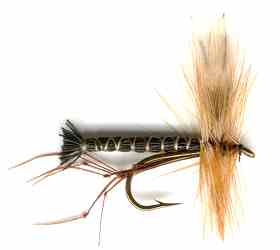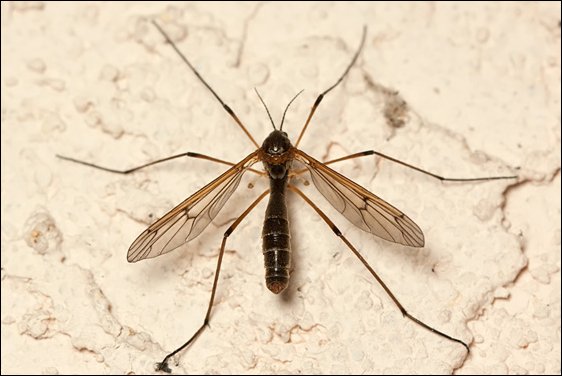Black Daddy Long Legs Crane Fly
The Black Daddy Long legs pattern imitates crane flies that have been blown onto a lake or reservoir and are stranded in the water surface film. The disturbance they make attracts the attention of trout who love to eat them.

Daddy Longlegs Dry Flies Hook size 10 - $US each
It was a nice summer’s evening and I had driven to my local lake in anticipation of catching the early stages of a Blue Dun hatch. When I got to the water nothing was moving. There was no surface activity and I could not detect any subsurface disturbances caused by trout looking for rising nymphs. I decided to tie on a black daddy longlegs. I had seen some dark bodied crane flies resting on tree trunks as I walked along the lake access path from the car park. I find a big dry often produces the occasional take when nothing else is happening. I so love taking a fish of a top fly. I think I prefer it to two fish taken deep.
I do not have to wait long. A brown shape drifts up in front of my black body daddy long leg fly and sips at it. What a fool I was. In the excitement I miss it by striking too quick and the fly falls out. Ten minutes later my daddy longlegs receives more attention. This time I wait until the trout fully sips in the fly before striking. This time a success. I landed a healthy 1lb brown trout which I quickly released.

The natural black Daddy Long Legs Crane Fly
Fly Fishing with Daddy Longlegs tips
A helpless large daddy longlegs fly trapped in the water surface film represents a large calorie filled meal for a hungry trout. They are always on the lookout for these supersized meals and this is why you should have a few in your fly box. As soon as you see them flying near the water you are fishing swap your fly patterns and try your luck with a daddy-longlegs imitation.
A helpless large daddy longlegs fly trapped in the water surface film represents a large calorie filled meal for a hungry trout. They are always on the lookout for these supersized meals and this is why you should have a few in your fly box. As soon as you see them flying near the water you are fishing swap your fly patterns and try your luck with a daddy-longlegs imitation.
They all have long slender bodies and gangly legs. Their wings are long and narrow. The majority of crane flies deposit their eggs away from the water, in soft soil, moss or under leaves and other rotting vegetation that forms a woodland carpet. A few species are aquatic in nature, like the big Tipula Maxima whose larvae live within the mud and silt of the water margins.
The eggs develop quickly. On hatching the larvae are legless worm like creatures. It under goes a number of changes before it transforms into its adult stage. As an adult it no longer feeds. Its prime objective is to find a mate. It is only the adult stage of a crane fly’s life cycle that is of interest to the fly fisherman.
Crane flies are poor fliers and cannot cope with bad weather conditions. Even gentle breezes will blow them off course and over stretches of open water. Some are blown onto the water by strong gusts of winds or heavy downpours but many briefly alight on the surface because they are in a weakened state after a long flight. Many manage to take off again but some get stuck in the surface film, struggle and drown.
It is this apparent dancing on the water surface of those daddy-longlegs that can take off again after a rest that is easily emulated by the fly fisherman. I have caught many trout fishing a daddy-longlegs pattern on ‘the dap’. That is casting the fly so it rests on the surface for a short time before lifting it off again. This disturbance causes ripples that attract the attention of nearby fish. The come to the location to investigate what is going on and if there is anything they can eat.
By your third or fourth cast hopefully there will be a couple of fish on the lookout for the next fly to land on the surface. I really enjoy fishing these patterns on the dap but they can also be fished like a standard dry fly stationary on the surface, drifting with the current, with the odd twitch of the line to suggest life and the presence of a struggling insect trying to break free from the water surface tension.
Trout also expect to see the bodies of dead cane flies that have drown and been submerged by a small wave. You can fish your daddy long leg fly pattern sub surface in windy rough conditions and catch fish. I was fishing with friends on a loch n Scotland one summer. There were lots of crane flies in the air so we all started dapping with daddy-longleg patterns. We had lots of interest but no takes. The fish seemed to be bumping our flies rather than engulfing them with an open mouth. We were confused with this behaviour until it dawned on us that they were trying to drown the flies. We switched to fishing our flies sub surface and were soon hooked-up.
Normally the fish will take the dapped daddy longleg fly off the surface but if you see this unusual action be prepared to change tactics
CUSTOMER'S COMMENT
The handful of black Daddy Longlegs I ordered from you last time were a huge surprise and success last summer (hence the 30 I have ordered this time). I caught my best fish on them with some amazing takes. I have tried various colored Daddy's from different suppliers but none with the success of the Black Daddy from you guys. I have managed to get some stubborn deep sitting fat trout to rise to the Daddy where all else failed so a "Big Thanks" for that. Michael Clancy, Austria
CUSTOMER'S COMMENT
I fish Lough Rea in Co Galway, Ireland. It is a great location for dapping the daddy longlegs or grasshopper. It takes a good share of back-end trout in August. Jerry Browne, Dublin


Fly Fishing books

